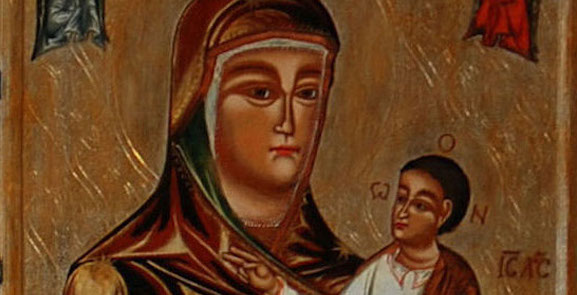
In a Hodegitria icon ("She who shows the way"), our Holy Mother points with her hand to the only way to follow: Christ. Like all icons of Mary, it bears the inscription "Mother of God" (Theotokos). On her forehead and shoulders, the three shining stars express the dogma that she is a virgin before, during and after the birth of her Son. The golden tunic of the Child indicates that everything is luminous in him. He is, according to the definition of the Council of Nicea: "God born of God, light born of light, true God born of true God."
According to tradition, the Hodegitria icon from Smolensk was painted by St. Luke for the community of Antioch (in present day Turkey). It was later moved to Constantinople and enshrined in the Blachernae church. In 1046, it was brought to Russia, and finally placed in the Smolensk Cathedral of the Assumption in 1101.
Mary Hodegitria was invoked to obtain advice and help. In particular, she helped Emperor Vladimir Monomachus (1053-1125) to pacify and unite Russia. She is credited with protecting the city from the invasion of the Tartars. In 1398, the icon was brought to the Cathedral of the Annunciation in Moscow, then it was returned to Smolensk and displayed in the Church of the Assumption of the Novodevi Monastery.
In 1812, the icon was transported to the battlefields during the war against Napoleon. Tolstoy wrote about this episode: "Before and around the icon, behind and on all sides, crowds of soldiers walked, ran and prostrated themselves to the ground, uncovering their heads." (in War and Peace).
On November 22, 1991, the icon mysteriously wept for a whole day. This miraculous lachrymation was seen by countless witnesses. The local bishops and patriarch recognized the phenomenon as authentic.
The Hodegitria Virgin of the Pure God-bearer (Theotokos or Mother of God) is celebrated on November 5 to commemorate the victory against Napoleon and on November 22, date on which she was seen crying in 1991.
The Marie de Nazareth editorial team